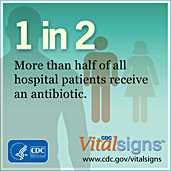| Reference |
Setting |
Key staff |
Intervention |
Impact |
Tools |
| Buising KL, Thursky KA, Robertson MB, Black JF, Street AC, Richards MJ, and Brown GV. Electronic antibiotic stewardship-reduced consumption of broad-spectrum antibiotics using a computerized antimicrobial approval system in a hospital setting. Journal of Antimicrobial Chemotherapy. 2008; 62:608-616 |
365-bed tertiary care teaching hospital, Melbourne, Australia |
Drug and Therapeutics Committee |
Electronic Monitoring-implementation of a computerized antimicrobial approval system for ordering restricted antibioics, limiting duration of dispensement and facilitating communication with pharmacy, ID and prescribers |
Gradients in DDD for use in 3rd and 4th generation cephalosporins (+.52, -0.05, -0.39 p<.01), glycopeptides (+0.27, -0.52 p=0.09), carbapenems (0.12, -0.24 p=0.21), aminoglycosides (0.15, -0.27 p<0.01) and quinolones (0.76, 0.11 p=0.08) decreased over 5 years while extended-spectrum penicillin use increased (0.16, 1.16 p<0.01). Trends in improved susceptibility of S. aureus to methicillin and improved susceptibility of pseudomonas to many antibiotics observed |
— |
| Raymond DP, Pelletier SJ, Crabtree TD, Gleason TD, Hamm LL, Pruett TL, Sawyer RG. Impact of a rotating empiric antibiotic schedule on infectious mortality in an intensive care unit. Critical Care Medicine 2001; 29: 1101-1108 |
Tertiary care teaching hospital in the surgical and trauma ICU, Charlottsville, VA, USA |
ICU physicians |
cycling-2 year study during which the first year had nonprotocal-driven antibiotic use compared with the second year during which a quarterly rotating empiric antibiotic schedule was used |
significant reductions in the incidence of antibiotic-resistant Gram-positive coccal infections (7.8 infections/100 admissions vs. 14.6 infections/100 admissions, p < .0001), antibiotic-resistant Gram-negative bacillary infections (2.5 infections/100 admissions vs. 7.7 infections/100 admissions, p < .0001), and mortality associated with infection (2.9 deaths/100 admissions vs. 9.6 deaths/100 admissions, p < .0001) during rotation.Antibiotic rotation was an independent predictor of survival (OR 6.27, 95% CI 2.78–14.16). |
— |
| Cook PP, Catrou P, Gooch M, Holbert D. Effect of reduction in ciprofloxacin use on prevalence of methicillin-resistant Staphylococcus aureus rates within individual units of a tertiary care hospital. Journal of Hospital Infection. 2006; 64: 348-351 |
731-bed tertiary care teaching hospital, Greenville, NC, USA |
Antimicrobial management program, pharmacists |
Reduction-Active monitoring of oral and IV ciprofloxacin use. Pharmacists would contact prescribers with recommendations for changing to alternative abx or d/c'ing abx based on micro data from individual patient |
Examined units with >10 isolates of S. aureus comparing 2004 and 2005 data. In 17 unites, ciprofloxacin use decreased by 31.2% (p<0.0001). MRSA rates decreased from 59.6% to 54.2% (p=0.112). Correlation between cipro use and MRSA rates (r=0.70; 95% CI -0.01-0.94 p=0.053) |
— |
| Rahal JJ, Urban C, Horn D, Freeman K, Segal-Maurer S, Maurer J, Mariano N, Marks S, Burns JM, Dominick D, Lim M. Class restriction of cephalosporin use to control total cephalosporin resistance in nosocomial Klebsiella. JAMA, 1998;280(14): 1233-1237 |
500-bed university affiliated community hospital, Queens, NY, USA |
infectious disease physicians |
Restriction-Hospital adopted antibiotic guidelines restricting routine cephalosporin use and requiring primary team to seek ID approval for use |
80.1% reduction in hospital-wide cephalosporin use in 1996 compared to 1995. 44% reduction in incidence of ceftazidime-resistant Klebsiella infection and colonization throughout medical center (p<0.01) and 70.9% reduction in all intensive care units (p<0.001) and 87.5% reduction in SICU). 68.7% increase in incidence of imipenem-resistant pseudomonas throughtout the hospital (p<0.01). |
— |
| Bantar C, Sartori B, Vesco E, Heft C, Saúl M, Salamone F, Oliva ME. A hospitalwide intervention program to optimize the quality of antibiotic use: impact on prescribing practice, antibiotic consumption, cost savings, and bacterial resistance. CID 2003; 37(2): 180-186 |
250-bed public teaching hospital, Parana, Argentina |
Antimicrobial Treatment Committee (infectious disease physician, clinical and laboratory microbiologist, pharmacist, general internist, and computer systems analyst |
Multidisciplinary-Over the course of 6 months, 4 step-wise interventions occurred. These were introduction of an optional antibiotic order form, feedback activities for prescribers and transforming the optional order form into a required one, creation of formal abx prescription policies and finally allowing the ATC to inteverne and actively revise inappropriate prescriptions |
Sustained reduction of drug consumption was shown during the study (R2=0.6885; P=.01). Total cost savings was 913,236 US dollars. 3rd gen cephalosporin resistance: E. coli NS 18/months, Klebsiella NS/18months, proteus 32.5% reduction/18months, Enterobacter cloacae 80% reduction/18 months; amp/sulbactam resistance: e. coli NS/18 months; imipenem/clilastatin resistance: pseudomonas 100% reduction/18 months; cefepime resistance: pseudomonas NS/18months; MRSA: 36.3% reduction/18 months |
antibiotic order form |




 ShareCompartir
ShareCompartir